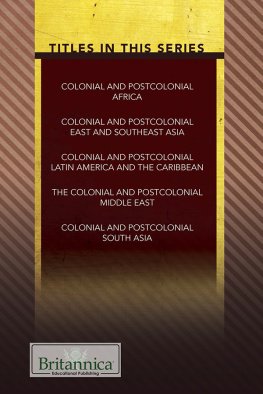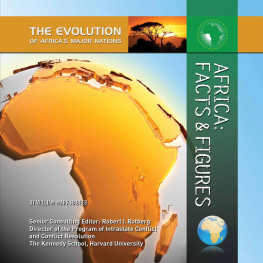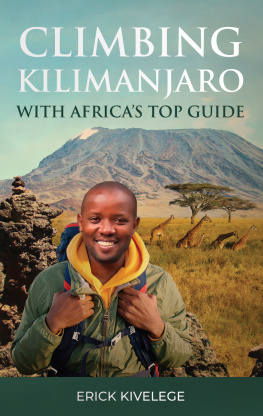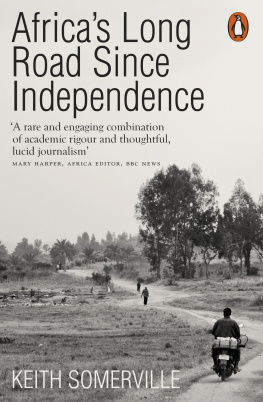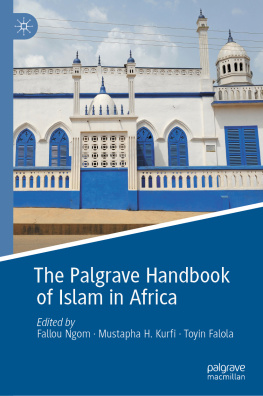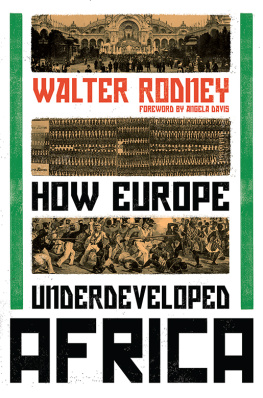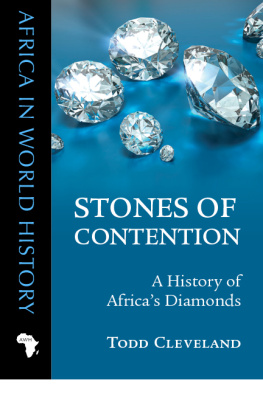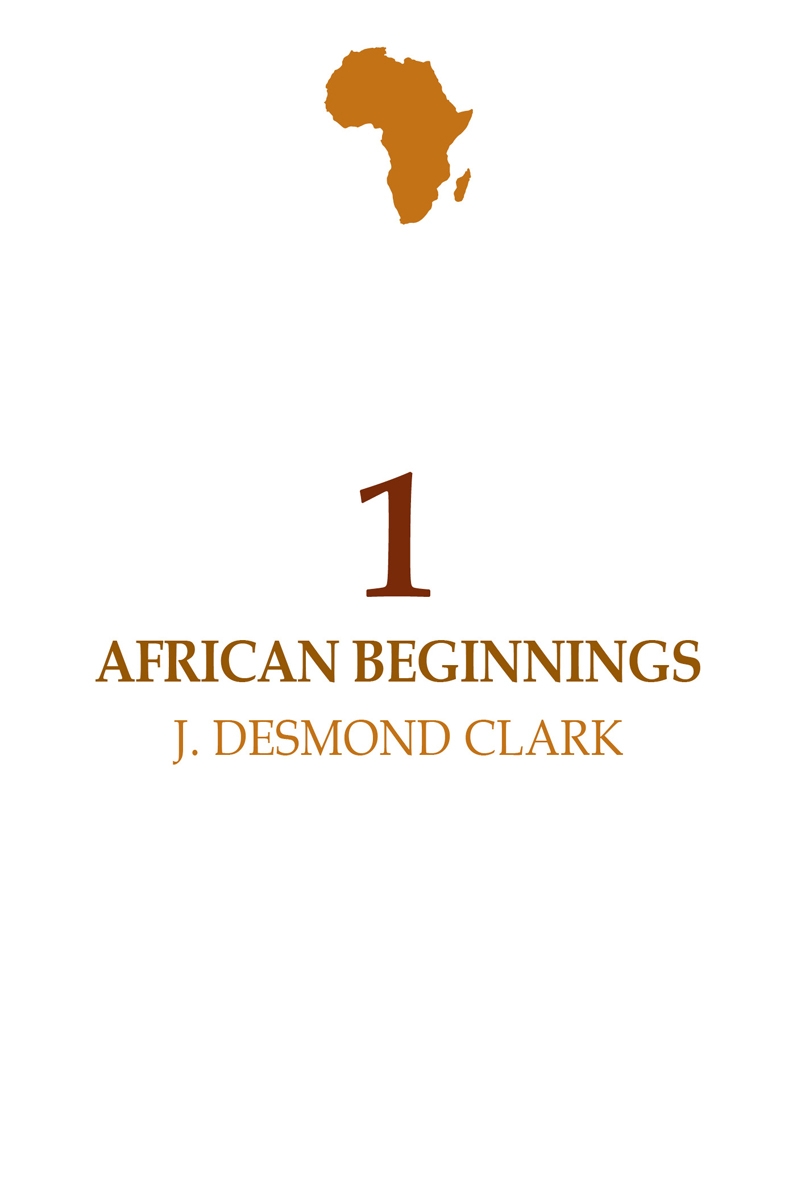For centuries, peoples imaginations have been captured by attempts, usually fanciful, to establish the exact locality of the place of origin of the human race - the paradise of an cient mythology . Scientific research of the last few decades, carried out by archeologists, paleontologists, and workers in allied disciplines, is making it increasingly li kely that the legendary birthplace was somewhere on the African conti nent, probably south of the Sahara.
Africa today is the home of many human cultural tradi tions, ranging from simple hunting societies to elaborate urban civilizations - a result of interaction over many mil lenniums and the selective use of the potentialities of the different environments. Indeed, the single most powerful influence on the lives of men, as of other creatures, is the environment in which they live. Temperature, rainfall and its distribution throughout the year - in short, climate - together with the kind of plant communities, the associ ated animal life, the availability of surface water sources or of economically important minerals not only shape the tenor of mans daily life but have been significant influences on his biological evolution.
Animals and plants are adapted to living in a particular habitat through natural selection and competition. Some creatures have succeeded in adapting to several different ecological niches, but by reason of mans culture and tech nology, only he and some life forms dependent upon him have been able to make adjustments that permit him to live anywhere he wants to in the world.
Humanitys emancipation from environmental controls has been a comparatively gradual process, though one of stead ily quickening tempo. For nine-tenths or so of human his tory, however, the rate of biological and cultural progress was extremely slow, almost imperceptible; only in the past few thousand years has man developed the abilities that make possible todays sophisticated urban civilizations. Nonetheless, man remains an integral part, though by far the most influential part, of the many different ecosystems in which he lives, and he now has it in his power to destroy or to conserve and improve them. Moreover, from the be ginning, mans relationship with his environment was one in which he always had the freedom to choose how he could make best use of the natural resources and which of them he should select.
It is the possession of a rational intellect and of culture - the ability to manufacture artifacts and the skill to use them - that gives man the opportunity to exploit the resources offered by the different habitats, and this finds expression in the patterns of behavior that control the lives of every hu man community. Depending on social, legal, and religious sanctions, all of which affect the way a population reacts to innovations and the pressures of external influences, a cul ture may be sympathetic or conservative in its acceptance and modification of new beliefs, tastes, or technologies.
In any community, the cultural tradition is made up of the social structure, the economic pattern, the learned ways of behavior, and the influence on these of technology and ma terial culture - all of which are handed down from one gener ation to the next. For example, in Africa, the peoples south of the Sahara may be separated generally into two geographi cal culture areas: those in the south and east, where hunt ing, wild food gathering, and the herding of livestock de termine the culture; those in West Africa and Equatoria, where the economy is based on cultivation by sedentary populations. The ways of life of the peoples in each of these main culture areas are broadly similar except where historical interaction has brought about some modification or displacement.
The concept of culture areas is of great value for the study of cultural evolution. Except in the latest, prehistoric periods, however, little evidence, other than the less perishable parts of the material culture, has survived. But as research becomes more advanced, archeology - the science that seeks to interpret these material remains - is able to provide a time perspective for some of the culture areas. An understanding of the main geographical regions of the continent is not only essential to an explanation of the varied ways of life of the African peoples today but is even more important for understanding the evolution of man and his culture in prehistoric times and his preference for and selection of some habitats rather than others.
Geographically, Africa can be divided roughly into a highland and a lowland zone by drawing a line from the mouth of the Congo River in the west to the Ethiopia-Sudan border in the east. South of this line, High Africa com prises mainly an interior plateau, most of it between 3,000 and 5,000 feet above sea level, but with higher ridges and mountains. The bedrock is formed of pre-Cambrian crystal line metamorphic rocks that also commonly obtrude, and some of them provide important sources of mineral wealth. North of our imaginary line, Low Africa composed largely of plains and basins of sedimentation in which are found the younger sedimentary rocks of Cretaceous and early Tertiary periods, is generally between and 2,000 feet above sea level.
In the depressions on the plateau are large, relatively shallow lakes and swamps containing a seemingly inex haustible supply of fish and, formerly, large numbers of hippopotamuses. The major rivers have their sources in the higher mountain ranges, from which they descend to un dulating savanna, meandering in broad, deep valleys until they reach the escarpments, where they fall in a series of rapids and waterfalls, often through narrow gorges, to the coastal plains. Thus, the rivers are never navigable for any great distance from their mouths. This feature was directly responsible for the general failure of alien peoples - travel ers, traders, soldiers, and geographers - from classical times into the nineteenth century to penetrate the interior and relay knowledge concerning the country and its inhabitants to the outside world.
The eastern part of Africa is split by a huge trough, or fault, that runs nearly the whole length of the continent. This is the Great Rift Valley, which starts in Asia, in Syria, and continues southward down the Red Sea, through Ethiopia into Kenya, Uganda, and Tanzania, and finally loses itself beneath the alluvial sediments in the lower Zambezi valley in Mozambique. In Kenya and Uganda, the trough splits into the Eastern Rift and the Western Rift; in a shallow basin on the plateau between the two branches lies Lake Victoria, Africas greatest lake.
The bottom of the Great Rift lies at extremely variable elevations. In the Danakil section of the Ethiopian Rift the bottom drops in places to nearly feet below sea level, but southward the floor rises in a series of steps until in Kenya, in the Eastern Rift, the elevation is over 5,000 feet. The volcanic rocks and sediments of the area support short grasses and thorn bushes, which are highly favorable to wild game and the pastoralist way of life.
The Great Rift is a technically unstable zone where compression and tension of the earths crust have pushed up the land bordering the trough into high ridges and mountains. The deeper portions of the trough are filled by great lakes, some of which, such as Lakes Tanganyika and Malawi, are among the deepest and longest in the world.
Although there exists now only one active volcano in the rift zone (Ol Doinyo Lengai in Tanzania), there are numer ous dormant and extinct ones, two of which Mount Kili manjaro (19,565 feet) and Mount Kenya (17,040 feet) are perpetually snowcapped. Another huge snow-covered mass - this one a crystalline rock thrust of nonvolcanic origin - is the Ruwenzori range. Its highest peak, Mount Stanley, rises to 16,795 feet. The vegetation zones of the rift run in belts around the mountains, changing with altitude from rain forest at the foot to alpine tundra near the top, and the scenery is some of the most beautiful and varied in the world. The rich fossil record preserved in the Great Rift Valley is due to the accumulation of deep sediments in the bottom of the trough and to the rapid burial of land surfaces by ash and dust from the volcanoes.



